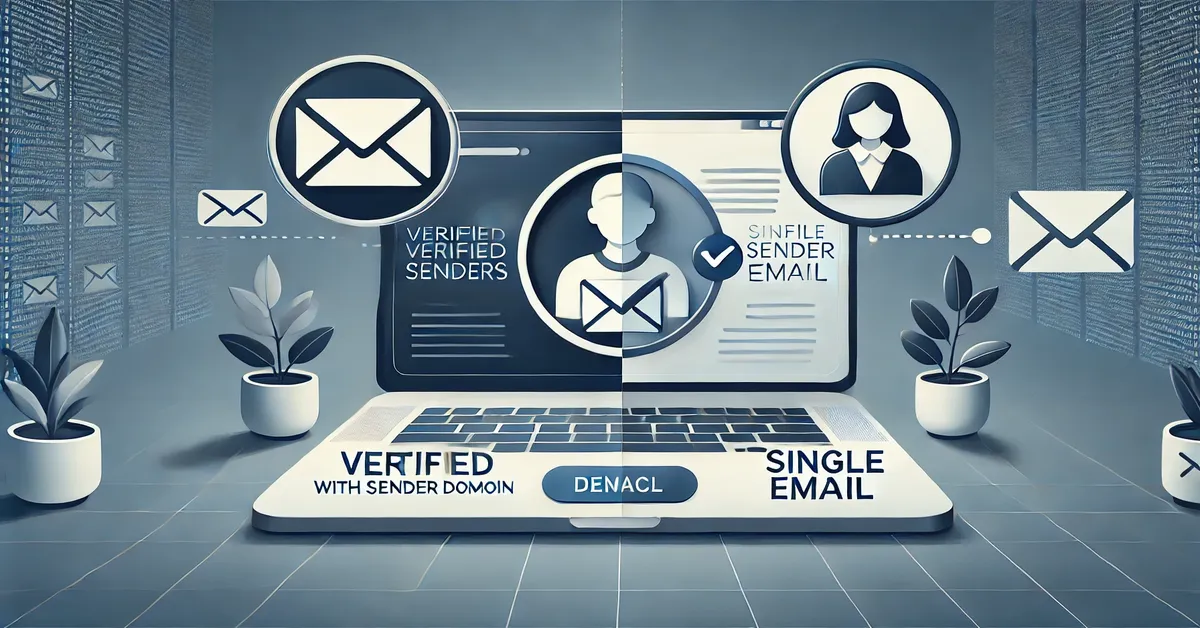In today’s world of digital communication, ensuring that your emails are delivered effectively and securely has never been more critical. Whether you are running a business, communicating with clients, or simply reaching out to colleagues, choosing the right email setup—sender domain or single sender emails—can significantly impact the reliability and professionalism of your communications.
This blog explores the differences between sender domain and single sender emails, their advantages and disadvantages, and how they can influence crucial processes like verifying the recipient’s address and ensuring compliance when managing tasks like sending US postage from Canada.
What Are Sender Domains and Single Sender Emails?
Sender Domains
A sender domain uses an organization’s custom domain (e.g., info@companyname.com). It is a professional email setup where all communications are sent from a domain that aligns with your brand identity.
Single Sender Emails
Single-sender emails, on the other hand, refer to personal or individual email accounts that use generic platforms such as Gmail, Yahoo, or Outlook (e.g., johndoe@gmail.com). These are often used for less formal or personal communications.
Key Differences Between Sender Domain and Single Sender Emails
1. Professionalism and Branding
- Sender Domain: Projects professionalism and strengthens brand identity. Emails sent from a custom domain reassure recipients that the message originates from a credible source.
- Single Sender Email: Typically lacks the branding element and might appear less professional, especially in formal business settings.
2. Trust and Deliverability
- Sender Domain: Verified sender domains significantly improve email deliverability rates as they are less likely to end up in spam folders.
- Single Sender Email: These accounts might trigger spam filters, especially when used for bulk or business communications.
3. Scalability
- Sender Domain: Best suited for organizations or businesses sending a high volume of emails.
- Single Sender Email: Ideal for individual use or limited, one-on-one communication.
4. Compliance and Security
- Sender Domain: Comes with enhanced security protocols like SPF, DKIM, and DMARC to authenticate emails and reduce risks of phishing or fraud.
- Single Sender Email: This may lack advanced authentication protocols, leaving emails more vulnerable.
Why Verified Senders Are Crucial for Email Success
Verified senders—whether from a domain or a single sender—help maintain trust and deliverability. When emails are authenticated, recipients are more likely to engage with the content, improving overall communication effectiveness.
Importance in Verifying Recipient’s Address
When dealing with sensitive processes such as verifying a recipient’s address, using a verified sender is critical. For example, businesses that rely on address verification for sending invoices, direct mail, or packages need to ensure their emails are trusted and not flagged as suspicious. This trust improves response rates and ensures timely interactions.
Choosing Between Sender Domain and Single Sender Emails
Your choice between sender domain and single sender emails should depend on the purpose, audience, and scale of your communication.
Opt for Sender Domain If:
- You are running a business or organization that requires professional communication.
- Branding is essential to your email strategy.
- You regularly engage in bulk emailing campaigns or automated communications.
Stick to Single Sender Email If:
- You need a personal email account for one-on-one communication.
- Formality and branding are not priorities.
- You’re handling minimal email volume.
When Sender Domain Matters Most
Business Operations and Marketing
For activities like email marketing, sales outreach, or US postage from Canada, sender domains are essential. Imagine a Canadian business sending promotional offers or invoices to US-based customers. Using a sender domain adds credibility and ensures compliance with email marketing regulations. Moreover, accurate postage calculations and address verification are streamlined through email communications, thanks to reliable sender domains.
Enhancing Cross-Border Mailing
Sending US postage from Canada requires seamless coordination. For example, Canadian businesses mailing products or invoices to US customers must calculate postage rates accurately and ensure prompt delivery. Verified sender domains simplify this process, ensuring every step—right from verification to delivery—is smooth and professional.
When Single Sender Emails Can Work
Personal or One-off Communications
If you are sending informal updates or one-off emails to clients, single-sender emails can suffice. However, they are not ideal for bulk or recurring professional communications.
Challenges of Single Sender Emails in Business
Using a personal email account for business purposes can lead to several challenges:
- Emails may get flagged as spam, resulting in poor deliverability.
- Lack of authentication may erode trust among recipients.
- The absence of branding could weaken customer perception.
Steps to Verify Your Email Sender
Whether you choose a sender domain or a single sender email, verifying your email sender is crucial. Here’s how you can do it:
For Sender Domains
- Set up SPF, DKIM, and DMARC records.
- Test your domain using email verification tools.
- Use professional email marketing platforms to send your emails.
For Single Sender Emails
- Authenticate your email account on the platform (e.g., Gmail, Outlook).
- Avoid sending bulk emails through a personal account.
- Ensure your email content is aligned with the recipient’s preferences to avoid being flagged as spam.
Best Practices for Choosing Verified Senders
- Align Sender Type with Purpose: Use sender domains for professional and bulk communications, and single sender emails for personal or informal interactions.
- Focus on Security: Always implement robust email authentication protocols to protect your communication.
- Prioritize Branding: For businesses, a sender domain is a must-have to maintain brand consistency.
Conclusion
Verified senders play a pivotal role in email communications, influencing trust, deliverability, and overall success. While sender domains are ideal for businesses requiring professional and secure communications, single-sender emails work well for individual or informal purposes.
When handling critical processes like verifying a recipient’s address or managing US postage from Canada, leveraging a sender domain ensures seamless and credible communication.
Choose wisely based on your communication needs, and always prioritize verification to maximize the effectiveness of your emails.







